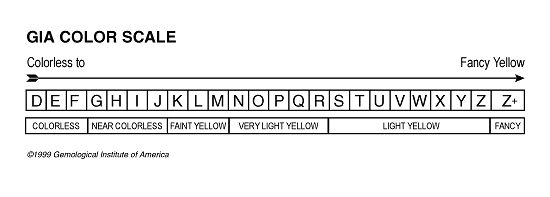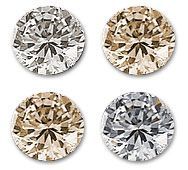Color
Color
Most diamonds cut for jewelry appear white or nearly so. But, in actuality, there is a wide spectrum of color from colorless to perceptibly yellow or brown. When diamonds possess so much body color they must be classified as colored stones, they are called “fancy color”. It is safe to say that 99% of the diamonds seen in jewelry stores are diamonds that are either colorless or nearly so. In most cases, color grading is done using a ratings scale developed and introduced by the Gemological Institute of America in 1953.
This scale consists of 23 letter ratings that ran alphabetically from D (totally colorless) to Z (noticeably yellow). Why, you ask, did GIA avoid use of A, B, or C color grades? Well, many color ratings systems in use in the 1950′s had top grades using these letters. Gia wanted to avoid confusion between its system and others. To arrive at a color rating, a gemologist compares the diamond to be graded to stones in a set of pre-graded diamonds called “master stones” under proper lighting and always in the face-down position. While top-colorless diamonds graded D, E, and F are considered the best, diamonds graded G, H, or I are still considered white. Only stones with J or lower color grades begin to exhibit increasingly perceptible amounts of color with shape, proportion, polish and symmetry.
Color Grades
Accurate color grading is important because a difference of a grade or two can affect a stone’s value by thousands of dollars. As anyone knows who has seen the hope diamond at the Smithsonian Institute in Washington, D.C., diamonds come in colors. In fact, they come in every one of the 14 colors recognized by the National Bureau of Standards.
When they possess sufficient color to be classified as colored gems, diamonds are referred to as “fancy color”. Of these, the rarest and most valuable are blue, pink, and green. Fancy yellow and brown diamonds are far more abundant. Since diamonds colored safely and permanently by irradiation that look identical to natural – color diamonds are widely available, it is important to have a report from an expert gem lab verifying a diamond’s color origin.


